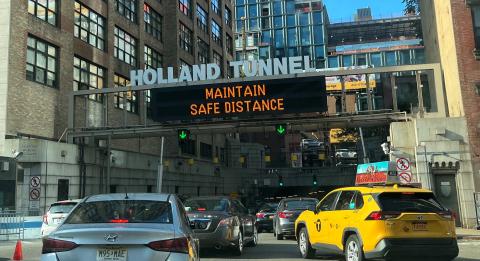
In 2000, the Port Authority of New York and New Jersey (PANYNJ) recognized the importance of establishing a strategic safety program based on industry standard practice to identify, prioritize, implement, and evaluate treatments for high hazard/high crash locations, and the need to access and maintain crash data to maximize data-driven decision-making.
The Traffic Safety Improvement Program (TSIP) was created with the objective to minimize the frequency, severity, and risk of motor vehicle crashes on the Agency’s roadway system by strategically focusing attention and resources on those areas where the data indicates the problem is the greatest. The program is administered with four key elements: Crash Records Management, Safety Data Analytics, Crash Mitigation (implementation), and Safety Performance Evaluations.
As part of the TSIP, the Port Authority created and maintains an innovative motor vehicle crash database, called the Crash Reporting & Analysis for Streets and Highways (CRASH) system. CRASH is a web-based system that utilizes GIS technology to expedite crash record data entry and retrieval, minimize data entry errors, and improve crash analysis capabilities. Additionally, the TSIP proactively identifies targeted, actionable, and achievable crash countermeasures that could be implemented on a system-wide approach. The systemic approach focuses on risk factors, including sight distances at unsignalized intersections, vehicle speeds at horizontal curves, speeding, and driver behavior.
A key factor in the effectiveness of the TSIP is having timely access to safety data, which could include police crash reports, construction activity data, recorded videos from CCTVs, traffic management center incident logs, and traffic volume data. The TSIP receives police reports daily and the CRASH database can be updated with a crash that occurred just the day before. The timeliness of available crash data means immediate access to real-time incident data and preliminary crash investigation reports to ensure rapid response to any system conditions that may have contributed to fatalities or serious injuries. Analysts perform weekly, monthly, and quarterly analyses to proactively identify short-term trends, crash patterns, and crash clusters along with volume data to identify and address safety issues.
All told, TSIP is a results-oriented and performance-based approach to safety. Since the inception of the program, annual crashes have been reduced by 46 percent Agency-wide, including a decrease of 48 percent at the tunnels and bridges, 43 percent at the airports, and 28 percent at the port facilities.
Additional Information

Kevin Walkes, Principal Engineer with the Port Authority of New York and New Jersey, accepted the Award at a Capitol Hill ceremony on November 29th.
